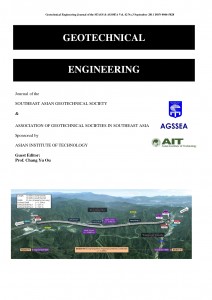Numerical Study on the Movement of Existing Tunnel Due to Deep Excavation in Shanghai
Main Article Content
Abstract
Adjacent excavation can have significant impact on the stress and deformation of existing tunnels. Several construction techniques have been proposed to reduce the movement of a metro tunnel due to two adjacent excavations in Shanghai. To evaluate the effectiveness of these different methods, the interactive impact of the two adjacent excavations on the crossing tunnel is studied numerically in this paper. The 2D FEM numerical analysis uses the Cam-clay model to simulate the behaviour of soft clay and considers the nonlinear performance of the soil-wall interface and the excavation sequences. The analysis investigates the influence of various factors, including the excavation procedure, installation of resistance piles, and relationship between the tunnel and the retaining wall of excavation. The results show that the crossing tunnel heaves during excavations because the distance between the two adjacent excavations is very small and the diaphragm walls for the original tunnel are used as the retaining structure of the new excavations. This predicted trend is verified by field measurements. The parametric study shows that dividing the whole dividing the whole excavation into several pit excavations and installing resistance piles tied to the tunnel can decrease the vertical displacement of the tunnel effectively.
Article Details

This work is licensed under a Creative Commons Attribution-NonCommercial-NoDerivatives 4.0 International License.
Copyright © 2019 Association of Geotechnical Societies in Southeast Asia (AGSSEA) - Southeast Asian Geotechnical Society (SEAGS).


